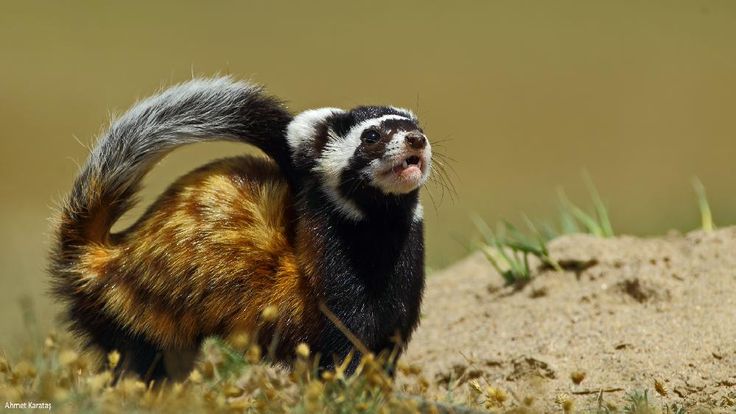European marbled polecat: Red Data Book of Armenia

Mustelids - Mustelidae
Status. Listed in the Red Data Book of the former USSR. Listed in the IUCN Red List of Threatened Species (ver. 3.1) as Vulnerable VU A2c. According to IUCN criteria categorized as Vulnerable VU A2c B1b(iii).
Distribution. Distributed from Southeastern Europe to the Middle East, South ern China and Mongolia.
Distribution in Armenia. Occurs in almost all regions of Armenia at 1000–2000 m above sea level. The range structure and ecology of this species are absolutely unexplored.
Habitats. Semi–deserts, arid mountain grasslands, mountain and subalpine meadows. Habitats overlap with distribution of rodents as the marbled polecat’s staple prey.
Biological traits. Mating occurs, most likely, in late winter. The gestation period is ca. 2 months. Four to eight cubs are born in April–May.
Population size and its trends. Unknown. It is essential to carry out relevant studies. Possibly, the population decreases because of habitat destruction and land encroachment for agricultural purposes.
Major threats. Habitat destruction. The major factors limiting the increase of polecat numbers are cultivation of semi–deserts and mountain grasslands, overgrazing and widespread use of pesticides and other chemicals.
Conservation measures. Protected in Khosrov Forest Reserve, Erebuni Reserve, Sevan National Park, Lake Arpi National Park and some sanctuaries. It is essential to strengthen control over agricultural activities and to prohibit the use of rodenticides.
Suggestions
 The Ministry of Environment sent a letter international partners to draw their attention to the real danger of environmental disasters as a result of Azerbaijan's large-scale aggression towards the territory of Armenia
The Ministry of Environment sent a letter international partners to draw their attention to the real danger of environmental disasters as a result of Azerbaijan's large-scale aggression towards the territory of Armenia
 Vicia pisiformis: Red Data Book of Armenia
Vicia pisiformis: Red Data Book of Armenia
 Vavilovia formosa: Red Data Book of Armenia
Vavilovia formosa: Red Data Book of Armenia
 Trigonella capitata: Red Data Book of Armenia
Trigonella capitata: Red Data Book of Armenia
 Trigonella astroides: Red Data Book of Armenia
Trigonella astroides: Red Data Book of Armenia












